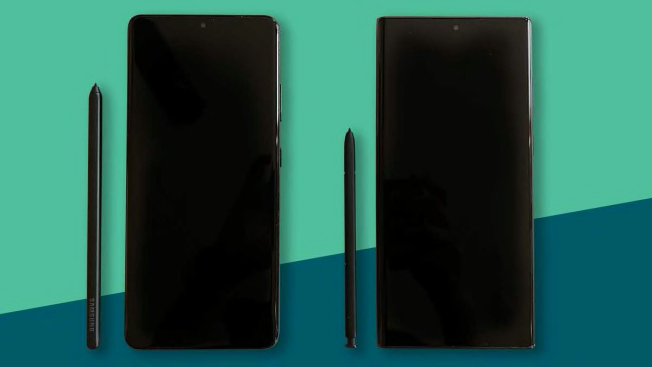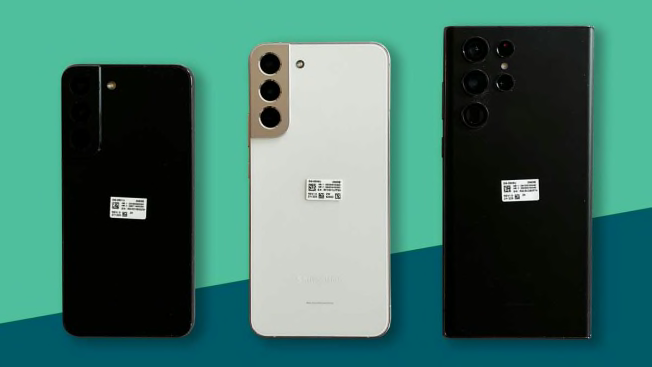Samsung's latest flagship phones gain a few hardware upgrades, but it’s the top-tier S22 Ultra’s redesign that steals the show

The new Samsung Galaxy S22, S22+, and S22 Ultra
By Melanie Pinola
Samsung’s new Galaxy S22, S22+, and S22 Ultra 5G smartphones come with appealing features like a new processor, advanced camera tricks, wireless charging, and 5G connectivity. But the most notable (no pun intended) development is the Galaxy S22 Ultra’s Note-like redesign, complete with the manufacturer’s ever-popular S Pen stylus.
The Galaxy S22 Ultra has essentially taken up the mantle of the Galaxy Note in look and feel, inheriting the sharp angles of the Galaxy Note20 Ultra and a silo for the included S Pen. The S Pen has more functionality now, too.
A Samsung representative says the company will “continue to reference the Note’s legacy but [will] be using the Ultra name moving forward.”
The Note is dead. Long live the Note Ultra!
The Ultra and its two siblings are available at 2021 prices, matching the original tags on their S21 counterparts. The base Galaxy S22 costs $800, while the Galaxy S22+ starts at $1,000 and the Galaxy S22 Ultra at $1,200. Available for pre-order now, the models arrive in stores Feb. 25.
Are they worth upgrading to?
We won’t know exactly how the phones stack up against the competition until we get retail versions into our labs. But here are the specs worth mentioning and my first impressions, based on press samples that I borrowed from Samsung.
The Galaxy S22 Ultra and Its S Pen
Let’s start with Samsung’s premium model because it’s the one that’s transformed the most from the previous generation.
Placing the Galaxy S22 Ultra next to the S21 Ultra I bought last year, it’s clear these are two different phones, despite their same 6.8-inch screen size (measured diagonally, as always).
The S22 Ultra has a squared-off top and bottom to accommodate the S Pen. In my view, the sharper edges give the phone a more buttoned-up look. The aluminum frame on the black model has a deep purple sheen at certain angles and lighting, which I appreciate for those Zen-like moments when I just contemplate my phone. If you prefer the traditionally curvier lines of the S series, the S22 and S22+ are this year’s options, but you’ll sacrifice the main reason to get the Ultra: a larger screen combined with S Pen capabilities.

The Galaxy S21 Ultra and its S Pen (left) look quite different from the new S22 Ultra and its S Pen (right).
Photo: Melanie Pinola/Consumer Reports
The new, built-in S Pen is thinner and shorter than the one designed for the S21 Ultra; again, it’s just like a Note’s stylus. The old S Pen is more comfortable for me to hold for long scribbling stints. But as a former owner of a Galaxy Note8, I welcome the S22 Ultra’s ability to quickly start writing on the lock screen just by removing the stylus. When someone mentions a book they recommend or you come up with a brilliant project idea, you can capture it on the lock screen on the fly, like you would with a notepad. That’s a trick the S21 Ultra can’t do because its S Pen (an optional $40 accessory) isn’t as closely integrated with the phone.
It’s nice to not have to worry about losing the S Pen or needing a case for it. In addition to providing a space for the S Pen in the phone, the Galaxy S22 Ultra will ask you whether you still have the stylus nearby if it’s been ejected from the phone and disconnected from it for a while.
Samsung says the S Pen can predict what you’re scribbling better than previous pens could and that reduced latency makes the stylus smoother to write with. In my short tests, I didn’t notice any difference when writing on the S22 Ultra’s screen vs. the one on the S21 Ultra. In both cases, the stylus glided smoothly across the glass and offered the same pleasant “pen scratching on paper” sound effect.
Also unique to the Galaxy S22 Ultra is an updated display refresh rate. Like last year’s models, the S22 phones all have adaptive 120Hz AMOLED screens. When it’s in action, the fast 120Hz refresh rate makes scrolling through content and playing games smoother. (The jump from 60Hz to 120Hz for the iPhone 13 Pro was a significant upgrade last year for Apple.)
However, a high refresh rate can be more demanding on the battery. To address that issue in its top phone, Samsung has kept the massive 5,000mAh battery capacity the same, but the S22 Ultra’s screen can now automatically adjust the refresh rate from 120Hz to just 1Hz to save battery life. The S21 Ultra goes down only to 10Hz, while the Galaxy S22 and S22+ can go from 120Hz to 48Hz.
We’ll be testing the S22 Ultra’s battery life in our lab to see whether the new screen technology means more juice for your phone.
Galaxy S22 and Galaxy S22+
The Samsung Galaxy S22 and S22+ models have undergone smaller makeovers than their larger sibling.
The 6.1-inch S22 and 6.6-inch S22+ are both a tad smaller (specifically, 0.1 inch) than their predecessors and a few grams lighter, too. When I asked my husband to compare the Galaxy S22 next to his own S21, he didn’t notice the size difference until I stacked the smaller S22 on top of the S21. In other words, the only thing worth noting here is that you might need to buy a new case if you upgrade.
However, because they’re slightly smaller this year, the Galaxy S22 and S22+ also have slightly smaller batteries. The small S22 has a 3,700mAh battery (down from 4,000mAh), and the medium-sized S22+ has a 4,500mAh battery (down from 5,000mAh).
The midtier Galaxy S22+ now supports 45W charging, matching the S22 Ultra. The S22 keeps the slower 25W charging of yesteryear. As with last year’s models, the new phones don’t come with a wall charger.
We’ll report back when we’ve run the battery tests in our labs to show what you can expect in real-life usage.

The camera housing for the Samsung Galaxy S22, S22+, and S22 Ultra (from left to right) has been redesigned.
Photo: Melanie Pinola/Consumer Reports
Camera Changes
In the end, the most significant improvements for the Galaxy S22 and S22+ come in the camera hardware. The photo improvements, both hardware- and software-based, are mostly geared toward low-light and nighttime shooting.
I found the photos and videos I took with all three cameras to be at least Instagram-worthy. I took side-by-side photos of my puppy (much to his chagrin) as he slept, ran away from me, and played in the yard. In a dark room, I took still photos of a giant stuffed animal (which couldn’t run away) using Night Mode, then did the same in a lamp-lit room using Portrait Mode.
I was looking for two of the biggest new camera features Samsung announced for its phones: better low-light photography and improved portraits (including pet portraits). Preliminary results were promising. However, these were all quick, amateur shoots, and in some cases the results weren’t noticeably different to me than the photos I took with the Galaxy S21 and S21 Ultra. We’ll know better once our labs have a chance to fully evaluate the image quality of all three phones.

Photos taken in Portrait Mode on a Samsung Galaxy S21 (left) vs. a Galaxy S22 (right). The S22 has sharper details, more saturation, and more contrast.
Photo: Melanie Pinola/Consumer Reports
More megapixels and bigger image sensors: Specs-wise, the main rear camera on each model has been upgraded with a larger sensor, and the resolution has been bumped from 12MP to 50MP. A larger sensor captures more light, which is useful if you shoot at night or, say, in a dimly lit restaurant. But more megapixels don’t always mean better quality photos or videos.
Both the Galaxy S22 and S22+ gained a new 10MP telephoto lens with 3x optical zoom, as well—useful, for example, for getting a less fuzzy closeup of your kitten without spooking it. Previous versions of these cameras relied on software to zoom into your subject. And, for comparison, the cameras on Apple’s iPhone 13 mini and iPhone 13 use purely digital zoom, while the iPhone 13 Pro models incorporate optical zooming. (The Galaxy S22 Ultra, like its predecessor, has two 10MP telephoto lenses, one with 3x and one with 10x zoom, in addition to the main 108MP camera.)
New AI camera tricks: The camera advances in the new models are largely software-based. Samsung says its new and enhanced AI-assisted tools can automatically sharpen details and reduce noise in photos, depending on your lighting conditions.
Samsung has boosted the Galaxy S22 Ultra’s total zoom from 30x to 100x, so you can take more detailed shots of, say, your kid across the soccer field or your favorite band at a concert. For videos, the phones can automatically adjust the frame rate, as well as the focus based on how many people join your shot.
For pro-level photography, the company says the S22 phones’ updated Portrait Mode does a better job of distinguishing human or pet hair from the background—a detail that separates a great photo from an okay one—and the Expert RAW app provides DSLR-like controls for adjusting white balance and changing ISO and shutter speed settings when you’re shooting and editing.
Other Updates
Samsung has packed other goodies into the new Galaxy S phones, although you might consider them more iterative updates rather than mind-blowing ones.
Processor: The Galaxy S22, S22+, and S22 Ultra are the first Samsung phones to use a 4nm processor. In theory, that should lead to better AI processing and graphics performance. It’s not likely to help you solve Wordle, but it could give you a performance boost if you’re running a more graphics-intensive game like Call of Duty.
Screen brightness: Samsung says it has increased the peak brightness of the screens on the Galaxy S22+ and S22 Ultra up to 1,750 nits (vs. 1,300 nits on the S21 models), which may create better contrast and a more brilliant picture quality, particularly when using the phones under direct sunlight. Screen brightness plays a big part in mobile HDR (High Dynamic Range) for streaming video and seeing all the details, regardless of lighting condition. We’ll take a closer look at that once we get the phones into our labs.
Upgraded materials: New for the Galaxy S series, the three S22 models have an Armor Aluminum frame, which the company says is more resistant to scratches than other materials. The phones have flatter and more prominent-looking edges than the S21 series, which had slightly curved edges. This is particularly notable on the white models, because the frame’s shiny silver color contrasts more with the phone’s black bezel and lock screen.
These are also the first phones to use Corning Gorilla Glass Victus+ on both the front and back. (The S21 phones have a plastic back.) The new glass is designed for better drop and scratch performance than the Gorilla Glass on other phones. We look forward to reviewing the phones’ durability in our rigorous tumble test.
New colors: All three Galaxy S22 phones are available in black, white, and green (the latter is new and looks more like a pine green than a lime or army green). The S22 and S22+ can also be ordered in a pink gold. For the Galaxy S22 Ultra, the alternative option is burgundy. And, if you order the phones from Samsung, you get three extra options: graphite, red, and sky blue.
Should You Get a Samsung Galaxy S22 Smartphone?
Aside from the S22 Ultra’s transformation into a Galaxy Note, the changes for this year’s crop of S22 smartphones haven’t been groundbreaking. They boast the newer processor and camera capabilities we expect every year. So if you’re phone shopping, you might wonder whether it’s worth buying a previous year’s model instead of a Galaxy S22 to save some money.
The answer, as it often is: It depends.
If you’ve been waiting for the successor to the Note20, the Galaxy S22 Ultra is it. It has the same S Pen experience as the Note20 Ultra and Note20, but it packs more advanced cameras, a higher resolution display, more memory, and a larger battery. (Me? As a previous Note owner and bona fide stylus user, the S22 Ultra would be the logical upgrade for me . . . if I didn’t already own the S21 Ultra that also lets me write on the screen.)
If you want a phone you can use one-handed or you often shoot photos or videos in the dark, the S22 or S22+ might be the new phone you’re looking for because of their smaller sizes and larger camera sensors.
In any case, there’s a lot under the hood for all of these new phones, especially if you consider the prices, which are the same as they were for the S21 models when they were new, last year. They’re even $200 cheaper than their counterparts in 2020.
We’ll soon have detailed performance tests on all of these phones to see how they stack up to other phones you might be considering.
Consumer Reports is an independent, nonprofit organization that works side by side with consumers to create a fairer, safer, and healthier world. CR does not endorse products or services, and does not accept advertising. Copyright © 2022, Consumer Reports, Inc.
